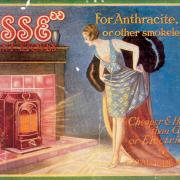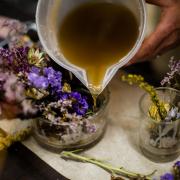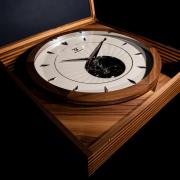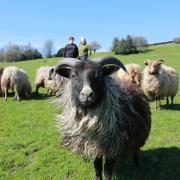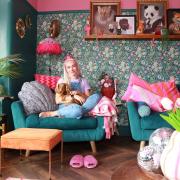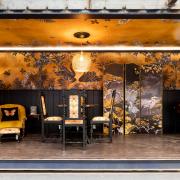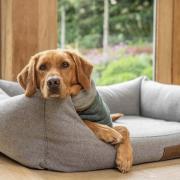An unofficial mascot of the Lake District, the Herdwick sheep is much loved, although its once valuable fleece is no longer in demand. But a Cumbrian gift company and a co-operative of farmers have found an innovative use for the wiry wool.
Once upon a time, the money from the wool clip – the payment received for the Herdwick fleeces after shearing – would pay the year’s rent for a Cumbrian hill farm. But today, the Lake District’s farmers must pay more to have the sheep clipped than the fleece is worth.
Although Herdwick wool is used for carpets and tweed for bags and accessories, it isn’t suitable for clothes. It’s coarseness and wiriness, which are the very qualities that enable the Herdwick to survive life on the high fells, make it itchy and uncomfortable to wear next to the skin.
But working together, two northern companies have discovered that, once combined with cotton fibre, the Herdwick wool’s natural spring and bounce make it the perfect addition to something we all need: a mattress.
The third vital participant in the project is a co-operative of Lakeland farmers who supply fleeces for the mattresses and receive an above market rate for the wool.

The mattress company, Herdy Sleep, was launched by Diane and Spencer Hannah, founders of The Herdy Company, whose colourful gifts, homeware and clothing, featuring a stylised and smiling Herdwick sheep, have done much to popularise the breed.
The firm already uses Herdwick wool for its Herdy Country range of tweed caps and bags and Spencer and Diane were keen to find other uses.

‘Since we started the brand in 2007, we’ve always tried to support British manufacturing when we can and making use of Herdwick wool has been part of our portfolio,’ said Spencer. ‘But then making sure the brand has got a good social purpose is really critical. The mattress was a fantastic opportunity to really champion the wool and almost give it a purpose, a bit like it used to have when the British wool carpet industry would have used Herdwick.’
They teamed up with Simon Spinks, of family-owned traditional pocket sprung mattress manufacturer Harrison Spinks, in Leeds, to develop a high quality mattress with a top layer that combines Herdwick wool with cotton fibre.
Since its launch, the design has been tweaked so each mattress is now glue and foam-free and is 100 per cent recyclable at the end of its life.
Spencer calculates that approximately two fleeces are used in a double Herdy Sleep mattress. Once the fleeces are collected, they’re taken to Bradford for scouring or cleaning before they’re turned into a mat or pad which is used as the top layer of the mattress.

Sam and Candida Hodgson, who are tenant farmers at the National Trust-owned Glencoyne Farm in Ullswater, have been working with Herdy Sleep for several years. They have about 500 Herdwicks and send a proportion of their fleeces to be used in the mattress manufacture.
Candida said that they already knew of The Herdy Company, which had helped raise the profile of the Herdwick breed, when they became involved. ‘Their products are lovely and they tell a good story about the sheep and the fells and fell farming,’ she added.
Traditionally, Herdwicks were farmed for meat and wool but the low grade wool is no longer in high demand.
‘Historically the wool clip would pay the rent,’ Candida said. ‘The wool clip doesn’t cover the cost of the shearers but we don’t want to throw it away. The sheep have to be sheared for welfare, so for the fleeces to go into a nice product, which again opens up a story and is using natural fibres, has got to be a great thing.’

Candida said that using more natural fibres is an important part of changes we need to make to care for the environment, even though she agrees that Herdwick wool isn’t suitable for clothes.
‘Wool has been used for a long, long time and the only reason it doesn’t fit our modern life is it’s not so good to wash. People are going to have to stop using synthetic fibres – and of course they shed micro fibres when you wash them. We should all be heading back to natural fibres but you won’t catch me wearing a Herdwick jumper.’

Herdy Sleep is buying a relatively small number of the farm’s fleeces, although at a higher fee than the British Wool Marketing Board.
But for Candida, the benefits aren’t financial. ‘We’re not in this business for producing wool but if somebody promotes it as a nice, natural product and encourages people to use more natural products, it has a knock-on effect. Anything that promotes wool as a good, natural fibre has got to be good for everybody.’

Spencer said that the mattresses are naturally hypoallergenic and antibacterial and control the body’s temperature, keeping it warm when it’s cold and vice versa, as the wool does for the sheep.
He said: ‘We’re not going to change the world. It’s not merino, but it’s got a lot of bounce and resilience and it’s hard-wearing. It’s a really good character set for a mattress and a real opportunity to champion this wool and make good use of it and find something that’s got a long-term opportunity.’
A breed apart

Herdwick sheep are virtually unique to the Lake District and the breed has evolved in harmony with its habitat to become a vital part of the delicate ecology and economy of the area.
They are thought to have come to Britain with the Vikings a thousand years ago, and Herdwick enthusiasts have always been proud of the breed – in 1878 William Abbot of Coniston wrote in The New Shepherd’s Guide of ‘the hardy Herdwick always to the fore, ready to climb to the summits of the loftiest mountains and proudly look down on less exalted, less beautiful fellow creatures’.
Beatrix Potter was a big fan too, keeping Herdwicks on her farms, winning prizes for her ewes at shows and acting as president of the Herdwick breed society. And when she left 15 of her farms to the National Trust, she did so on condition that they continued to graze Herdwick flocks.
The sheep were kept both for their wool and their meat, but the price for a fleece has plummeted, so most farmers shear their sheep purely for the animal’s welfare. The meat, however, has been recognised by foodies and connoisseurs as some of the finest lamb and mutton around.










